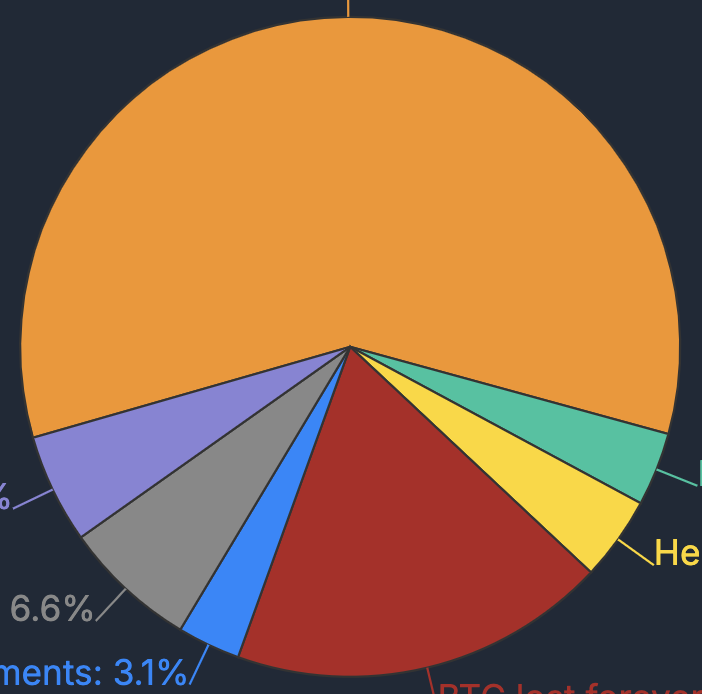Understanding Bitcoin's Tech: The Ledger and Blockchain

At its core, Bitcoin is purely information about transactions - there are no actual "coins," either physical or digital. Instead, Bitcoin exists as entries in a specialized database called the blockchain. This is similar to how 90% of traditional money exists only as digital records - for example, only about 10% of U.S. dollars exist as physical cash.
The Bitcoin Blockchain's Key Characteristics:
-
Distribution and Decentralization
- The ledger is stored across thousands of computers (nodes) worldwide
- Uses a peer-to-peer network structure with no central server
- Nodes can come and go freely; the network adapts automatically
- Operating in 100+ countries makes it resistant to government control
- Node count fluctuates with Bitcoin's price (more nodes when price rises)
-
The Immutable Chain Structure
- Transactions are grouped into "blocks" every ~10 minutes
-
Each block contains:
- A list of new transactions
- The cryptographic hash of the previous block
- A hash of its own contents
- Blocks are "chained" together through these hashes
- Changing any transaction would break the chain of hashes
-
To hack the blockchain, you'd need to:
- Modify the target block
- Recalculate all subsequent block hashes
- Convince thousands of nodes to accept the changes
- Do this faster than new blocks are being added
- This is computationally infeasible!
The Cryptography Behind Bitcoin
Bitcoin uses public-key cryptography in several clever ways:
-
Key Generation and Relationships
- Everything starts with a private key
- The private key generates a public key
- The public key generates a Bitcoin address
- All three are mathematically linked
- Example address: 1L7hHWfJL1dd7ZhQFgRv8ke1PTKAHoc9Tq
-
Transaction Signing Process
- To send Bitcoin, you create a message like: "Send X Bitcoin from Address A to Address B"
- Sign the message with your private key
- Include your public key with the message
-
Bitcoin network nodes (servers) can verify:
- The signature matches the public key
- The public key matches the sending address
- Only the private key holder could have created this signature
Bitcoin Wallets: Your Interface to the Network
Wallets are better thought of as "keychains" than storage containers:
- They don't actually hold Bitcoin
- They store your private/public key pairs
- They generate new addresses as needed
- They create and sign transactions
- They communicate with the Bitcoin network
- They track your balance by monitoring the blockchain
Types of Wallets:
- Hot wallets: Connected to the internet
- Cold wallets: Offline storage
- Hardware wallets: Dedicated devices
- Paper wallets: Printed key information
- Brain wallets: Memorized keys
- Metal wallets: Etched in metal for durability
Critical Security Principle: "Not your keys, not your Bitcoin"
- Whoever controls the private key controls the Bitcoin
- If someone else holds your keys (like an exchange), they control your Bitcoin
- Lost private keys mean permanently lost access to Bitcoin
- No "password reset" option exists
The Network in Action
When you make a Bitcoin transaction:
-
Your wallet:
- Creates the transaction message
- Signs it with your private key
- Broadcasts it to the Bitcoin network
-
Bitcoin nodes:
- Receive the transaction
- Verify the cryptographic signature
- Check that you have sufficient funds
- Add valid transactions to the "mempool"
- Eventually include them in a new block
-
The blockchain:
- Permanently records the transaction
- Makes it visible to all participants
- Prevents double-spending
- Maintains the complete transaction history
Important Technical Points:
- The blockchain is unencrypted and public
- Transactions are pseudonymous (not anonymous)
- Each block has a unique hash identifier
- Mining nodes compete to add new blocks
- New Bitcoin enters circulation through mining rewards
This architecture creates a system that is:
- Trustless: No need to trust any individual or organization
- Permissionless: Anyone can participate
- Censorship-resistant: No central point of control
- Transparent: All transactions are public
- Secure: Mathematically protected from tampering
- Global: Operates across borders
- Available: Runs 24/7/365
The genius of Bitcoin's design is how it combines these elements to create a decentralized currency system that can operate without any central authority. While the technology is complex, user interfaces are continuously improving to make Bitcoin more accessible to everyone.




































